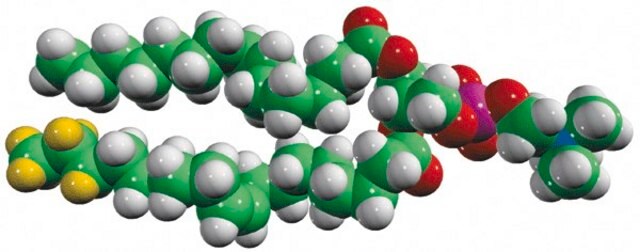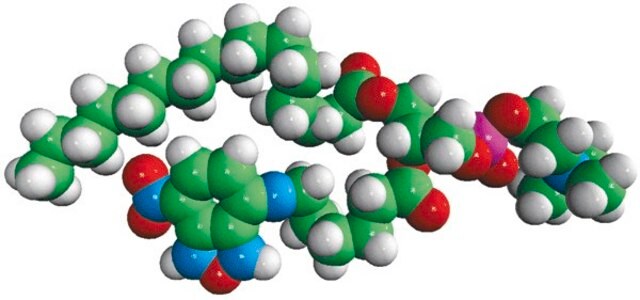Kluczowe dokumenty
857228P
Avanti
C18 LPA
1-O-octadecyl-2-hydroxy-sn-glycero-3-phosphate (ammonium salt), powder
Synonim(y):
1-octadecyl-sn-glycero-3-phosphate (ammonium salt); PA(18:0e/0:0)
About This Item
Polecane produkty
Próba
>99% (LPA; may contain up to 10% of the 2-LPA isomer)
Formularz
powder
opakowanie
pkg of 1 × 1 mg (857228P-1mg)
producent / nazwa handlowa
Avanti Research™ - A Croda Brand 857228P
typ lipidu
phospholipids
cardiolipins
Warunki transportu
dry ice
temp. przechowywania
−20°C
ciąg SMILES
O[C@](COP([O-])(O)=O)([H])COCCCCCCCCCCCCCCCCCC.[NH4+]
InChI
1S/C21H45O6P.H3N/c1-2-3-4-5-6-7-8-9-10-11-12-13-14-15-16-17-18-26-19-21(22)20-27-28(23,24)25;/h21-22H,2-20H2,1H3,(H2,23,24,25);1H3/t21-;/m1./s1
Klucz InChI
FFEGYFZPOUEMED-ZMBIFBSDSA-N
Opis ogólny
Zastosowanie
- to study its effects on Yes-associated protein (YAP) phosphorylation
- as a standard for the quantification of lysophosphatidic acid (LPA) compounds in proton samples using reversed-phase ultra-performance liquid chromatography-tandem mass spectrometer (UPLC-MS/MS)
- as a substrate to investigate the phosphatase activity of soluble epoxide hydrolase (sEH) towards LPA compounds
Działania biochem./fizjol.
Opakowanie
Informacje prawne
Kod klasy składowania
11 - Combustible Solids
Klasa zagrożenia wodnego (WGK)
WGK 3
Wybierz jedną z najnowszych wersji:
Certyfikaty analizy (CoA)
It looks like we've run into a problem, but you can still download Certificates of Analysis from our Dokumenty section.
Proszę o kontakt, jeśli potrzebna jest pomoc Obsługa Klienta
Masz już ten produkt?
Dokumenty związane z niedawno zakupionymi produktami zostały zamieszczone w Bibliotece dokumentów.
Nasz zespół naukowców ma doświadczenie we wszystkich obszarach badań, w tym w naukach przyrodniczych, materiałoznawstwie, syntezie chemicznej, chromatografii, analityce i wielu innych dziedzinach.
Skontaktuj się z zespołem ds. pomocy technicznej








